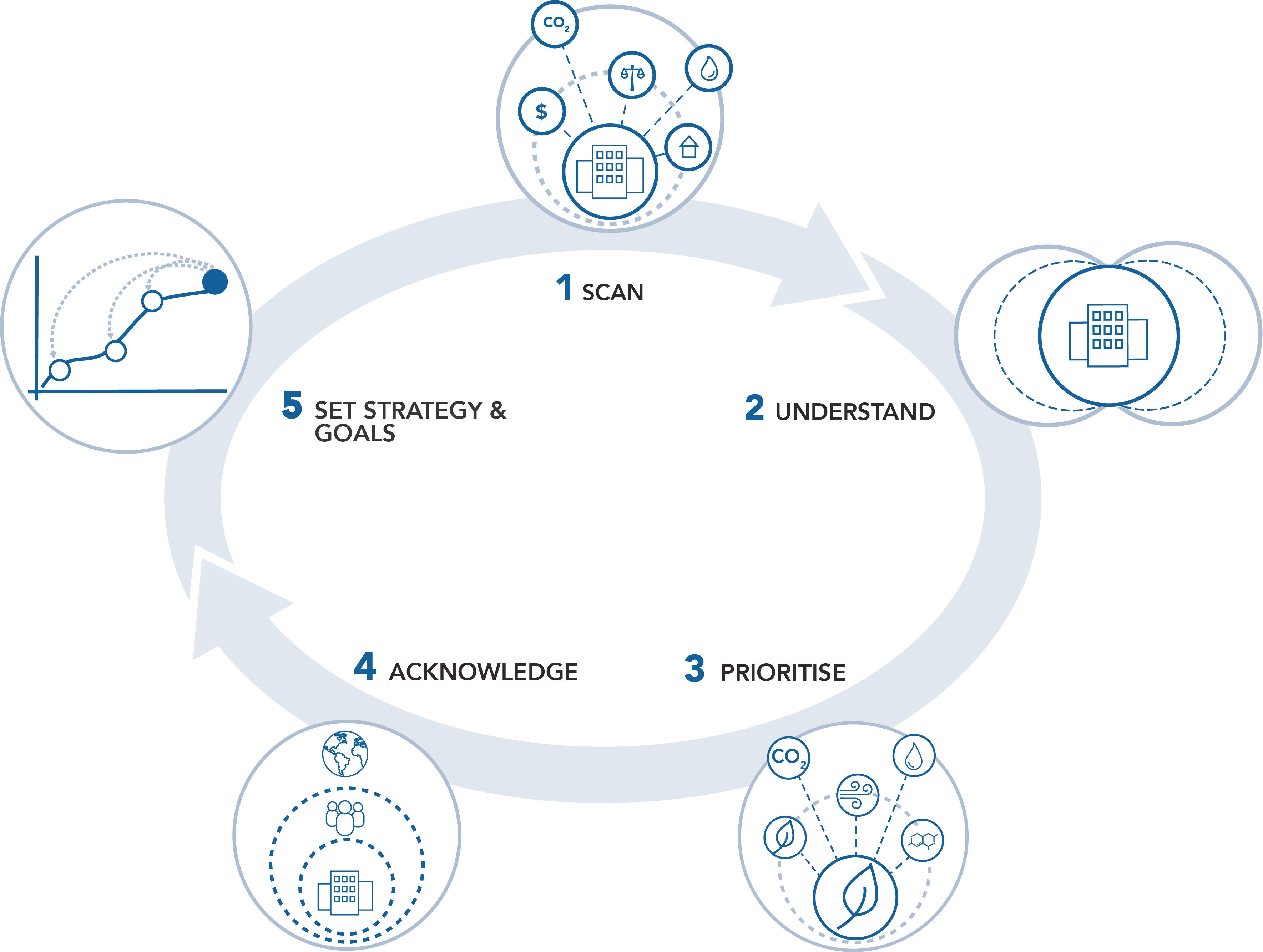5 Steps to a Corporate Strategy That Delivers on Sustainability
Share this post on:LinkedIn

Image by rihaij on Pixabay
Companies are realising that to do their part on sustainability, their approach to corporate strategy needs to shift.
More executives are coming to terms with the risks of not not doing enough to address their company’s impacts on society and the environment. To achieve the societal transformation that we need, corporations must do their part. This means embedding sustainability into your company’s core strategy.
And that means focusing on more than shareholder value or even stakeholder value …it means focusing on systems value. It means a corporate strategy process that aligns your actions with upholding the resilience of the environmental, social, and economic context in which your company operates.
Shifting to an embedded approach to strategy where businesses contribute to resilient communities and societies might sound idealistic, but our conversations with senior leaders in global companies have pointed to crucial moments where these system dependencies became apparent and provoked the realisation that business as usual is no longer an option.
As your company begins to recognise the crucial link between its own business resilience and the resilience of the social and environmental systems in which it operates, its strategy development process will need to shift. When supporting companies as they explore embedded strategies, we have found it helpful to structure our conversations around five iterative steps: scan, understand, prioritise, acknowledge, and set strategy & goals.
For more detail, you can read our Embedded Strategies guide, but this post helps to break down these five steps:

1) SCAN for issues
The first step towards solving any problem is knowing what problem you need to solve.
If you aren’t proactively scanning, you run the risk of missing the political, economic, social, technological, legal, and environmental issues that are most urgent and relevant to your business.
Take climate change, for example – with the launch of the Task Force for Climate-related Financial Disclosure (TCFD) guidelines, we saw many companies engage in a much more thorough scan for their potential physical and transition risks related to climate change.
Guess what? They found them. And often, more than they expected to find. That was scary for some heads of strategy and heads of risk. Suddenly they were wondering – what else is out there? What else haven’t we considered?
While many corporate strategy approaches do scan for emerging environmental and social trends, too often the focus is on tracking the potential for regulatory shifts and reputational risks or benchmarking against the disclosure and goal setting of competitors.
Unfortunately, this approach often doesn’t provide enough information to make sense of the specific challenges and opportunities that may apply to your unique operating context or help you to understand the full implications of these emerging risks.
Building an embedded strategy begins with looking beyond those issues that you have routinely identified or those that have traditionally been addressed in your sector.
Instead, you need to undertake a more thorough, proactive, systematic scan that begins with a comprehensive list of emerging issues and asks the question – to what extent could this issue be relevant to us? Which ones warrant further understanding and monitoring? Which ones require a strategic response?
Are you wondering where to start? We have vetted and compiled a list of useful resources that can help you develop a more structured scanning process.
2) UNDERSTAND your impacts and your potential for influence
To develop an embedded strategy, you will need to understand the social and environmental systems around you. This likely means that you will need to gather more information to build your contextual understanding of the underlying systems, their drivers, and the interactions between them.
But this will be more than just consulting with stakeholders.
You’ll want draw on a broader pool of expertise. Ideally, you’ll build ongoing communities of practice around key topics, drawing on internal and external knowledge holders with diverse views that can help enrich and evolve your understanding of key trends, timeframes for action, and the role your company should be playing in supporting systems resilience.
During this stage, you will need to better understand:
the underlying SYSTEMS NEEDS, which means the health, resilience, and key thresholds of underlying environmental, social, and/or economic systems;
the STRATEGIC RELEVANCE of these issues for your company in terms of risks and opportunities;
your OPERATIONAL IMPACTS proceeding from your direct operations;
your VALUE CHAIN IMPACTS, including those from suppliers, from customers using your products and/or services, and from your financing; and
your opportunities and leverage points for positive SYSTEMS INFLUENCE.
Often, we see that companies need to go through what we call a ‘committing to commit’ stage, where they commit to building the understanding they need to be able to set a credible strategy and goals in the future. This can take the form of committing to undertake basin-level water assessments or human rights assessments at all of your facilities, or it can involve listening to communities or suppliers to better understand your opportunities to contribute.
Building this understanding will also help to inform the way you rank and prioritise these issues and opportunities for action.
3) PRIORITISE
Strategy is about making hard decisions about where to direct limited resources and working within constraints.
But when it comes to prioritising among sustainability issues, many companies have come to rely on a materiality process that asks internal and external stakeholders to rank issues. It’s a process that was designed to help your company understand disclosure expectations, but has limitations when it comes to informing your company’s core strategy. Materiality processes like these can quickly become formulaic, failing to consider the constraints imposed by your context, making your company more vulnerable to systemic and emergent risks.
Embedded strategies involve multi-criteria decision-making that allocates your limited resources in a way that yields the greatest systems value.
That means using the information you gathered in the scan and understand steps to prioritise based on the strategic relevance of particular issues to your business, where your organisation has the greatest operational or value chain impacts, and where you are best positioned to positively influence the underlying systems.
You can learn more about how to do this here.
4) ACKNOWLEDGE
As we explained in our article about crafting a credible position statement, public scrutiny of businesses (and their leaders) is growing. Communities, investors, and your customers want to know that your company is doing its fair share to address issues like climate change, water scarcity, inequality, and racism.
They want your company to acknowledge the relevant issues. They want to see that you understand the issues, that you can link them to your business strategy, and that you’ve made credible commitments to address them.
We have seen first-hand how the development of credible position statements helps boards and executive teams deepen their understanding of specific issues; clarifies the link between the company’s overall strategy and the issues; clarifies their position for other key stakeholders; and provides the direction and confidence for management and employees to act. If your company intends to articulate a public statement, visit our curated list of resources to help you meaningfully acknowledge relevant sustainability issues.
5) SET GOALS AND INTERIM TARGETS
You’ve scanned for issues, worked to better understand the systems that underpin them, prioritised among them based on where you can deliver the greatest systems value, and you’ve acknowledged their relevance to your business and your duty to act.
Now it’s time to outline the action you’ll take to do your part.
Credible goals align with doing your part to contribute to systems resilience. Consider your current goals:
Are they set in alignment with maintaining systems resilience? Are you transparent in the assumptions you used in setting your goals? Have you set interim targets? Are they realistic? Do they reflect the investments needed to meet your desired endpoint?
There is still no ‘best way’ to set credible goals. Leading companies take many different approaches. The most important thing is to be as transparent as possible in how and why you are setting your goals. This allows internal and external stakeholders to understand your methodology and provide input. It also enables other companies to learn from your effort to set goals that better serve the environment and society.
To help support this final step, we created a free Goals Database to help you identify leading goals, and a handy, step-by-step article that walks you through the process of setting credible goals of your own.
Embedding sustainability into your company’s core strategy is neither quick nor easy. But following these five steps will put you on a solid path to getting there. It’s what stakeholders expect of you, and it’s what your company will need to remain resilient.